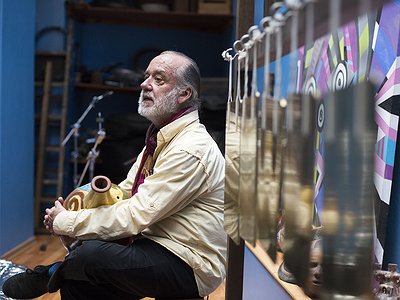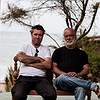Name: Manongo Mujica
Nationality: Perúvian
Occupation: Musician / percussionist / visual artist
Current release: Paracas Ritual on Buh Records
Recommendations: The Hidden Face of Music by Herbert Whone /The Furniture of Time painting by Yves Tanguy / Stalker by Andrei Tarkovsky
Album: “Paracas Ritual” by Manongo Mujica and Terje Evensen
Learn more about Manongo Mujica and buy his music at manongomujica.com
When did you start writing/producing music - and what or who were your early passions and influences? What is it about music and/or sound that drew you to it?
During childhood, I had that kind of experience that shapes one’s life. I used to spend so much time alone at the beach. It was a stone beach, so the sound of the shore was very powerful. One day, out of the blue, I got overwhelmed by the sound of the waves rolling the pebbles back and forth. It was as if this sound, the breathing of the tide, casted a spell on me and from that moment I have been following its lead throughout my life, by collecting and recreating the sounds Nature kindly places there for me to discover.
For most artists, originality is preceded by a phase of learning and, often, emulating others. What was this like for you: How would you describe your own development as an artist and the transition towards your own voice?
As teenager I had three sources or influences that gave me direction. First jazz. I would listen a lot to Miles Davis, his elegance, tone and phrasing. Then Oscar Peterson, his blend of virtuosity and feeling. Also, John Coltrane, his fearless attitude towards improvisation and his solos telling very intimate stories.
In the 60’s I was living in London, so I had the chance to listen to bands live, like King Crimson, The Cream, Soft Machine, Pink Floyd, and Led Zeppelin. At the same time, my curiosity for ethnic and sacred music from Africa, Asia and South America increasingly aroused. When I came back to Peru, after ten years in Europe, this blend of jazz, experimental rock and ethnic music converged in me, this time led by the experience of going back to my roots and rediscovering the sounds of the Peruvian landscape. I returned to listen with fresh new ears the landscape and immediately remembered my encounter with the sea back in the early years, reminding me of my commitment to record the sound of mother nature and enhance her textures, colours and rhythms. It was then that my voice took over and the journey became home.
How do you feel your sense of identity influences your creativity?
I could not escape my roots, I guess nobody can. Roots are in your blood, in your feelings, in the way you breath, defining your inner vision and, together with the stimuli you get from the very early impressions in your life, build up creativity as a result.
What were your main creative challenges in the beginning and how have they changed over time?
I think in the beginning, we all want to play or paint or write poetry no matter what, like a volcano exploding. Over time, the main change I experienced has to do with purpose or intention and how to share it in a metaphorical and coherent way through the music. Am I being totally honest in my performance? Is it clear that my piece of music has a beginning, a middle part and an end? Indeed, it is still a challenge as it is a long process of transformation of knowing exactly what you want to express and how to do it.
As creative goals and technical abilities change, so does the need for different tools of expression, from instruments via software tools to recording equipment. Can you describe this path for you starting from your first studio/first instrument? What motivated some of the choices you made in terms of instruments/tools/equipment over the years?
A major creative goal in my early years was to recreate the sound of the sea. So, as a drummer-composer, I put all my energy not only in my technique abilities, but in discovering a new concept in the art of drumming since I realized I didn’t want to play only with sticks and mallets. Perhaps my devotion to brushes made me explore and play with all kinds of papers, rubbing the skins of the drums in a continuous movement. This idea led me to learning to play the cello because ultimately, I wanted to play my cymbals with a bow. To play drums as if they were a cello in the middle of the desert. The bow gave me the sense of continuity because I started to listen to the landscape as a constant slow movement and so, the textural and atmospheric element, became very important to me. So, it is not drumming as a source of rhythm but drumming as a voice coming from the depths of nature. Neither am I the one who plays the instrument but is Nature herself who plays through me as if the musician could become the instrument himself. That is why I have always felt open to use whatever tool Nature demands on each piece I work on, for the sake of evoking her will.
Have there been technologies or instruments which have profoundly changed or even questioned the way you make music?
Many years ago, an American photographer held a series of workshops on creativity in Lima and I was hired to interpret for him. The photographer was Minor White. I was very touched by his approach of transmitting art because in his search of discovering the image, he developed a technique related to sensing your body while looking at the object to be photographed.
After the workshop, I would go back to my studio and apply this same technique of sensing my body but focused on my playing. A very simple and creative technique apparently designed for learning how to see, became relevant to my practise to learn how to listen.
Collaborations can take on many forms. What role do they play in your approach and what are your preferred ways of engaging with other creatives through, for example, file sharing, jamming or just talking about ideas?
Indeed, collaborations can take many different forms and since the sound of Nature is a very complex one, I consider collaborations as a very valuable tool to open up new possibilities and discover new ways to recreate these sounds. In my case, when it comes to music, I prefer jamming because jamming doesn’t lie. You can feel it in your skin, whether the person you are playing with has the right attitude, or his listening is open enough. It is a very useful tool to discover if the collaboration will succeed from the very beginning.
Take us through a day in your life, from a possible morning routine through to your work, please. Do you have a fixed schedule? How do music and other aspects of your life feed back into each other - do you separate them or instead try to make them blend seamlessly?
For me, it all comes to each day’s aim. So, first thing in the morning is listening in silence. What is it that I want to discover today? As of my playing, if the aim of the day is “to listen to my emotions”, then I will create the conditions needed to challenge myself to go through that very precise task. There are many exercises I put in place in order to commit to the task. One that works for me is to imagine myself alone in the middle of the sea in a small boat and all of a sudden, a huge storm comes up. How am I going to reach the port? So, I start elaborating upon that situation, sound wise. I have the sea element, the boat, the fear of the storm coming, the need to reach the port as soon as possible. These are the references I should use to tell the story in musical terms. Later on, when the sound engineer arrives in the studio in order to record this piece, I have already tried many times “to be in the sea”, “to listen to the storm” and “to connect with the fear of losing my life in the midst of the sea”. Now my body, my mind and feelings are ready for recording. I have come close to my aim of the day. I am not sure if I answered your question, but this is how my days have been looking like for the last forty years.



